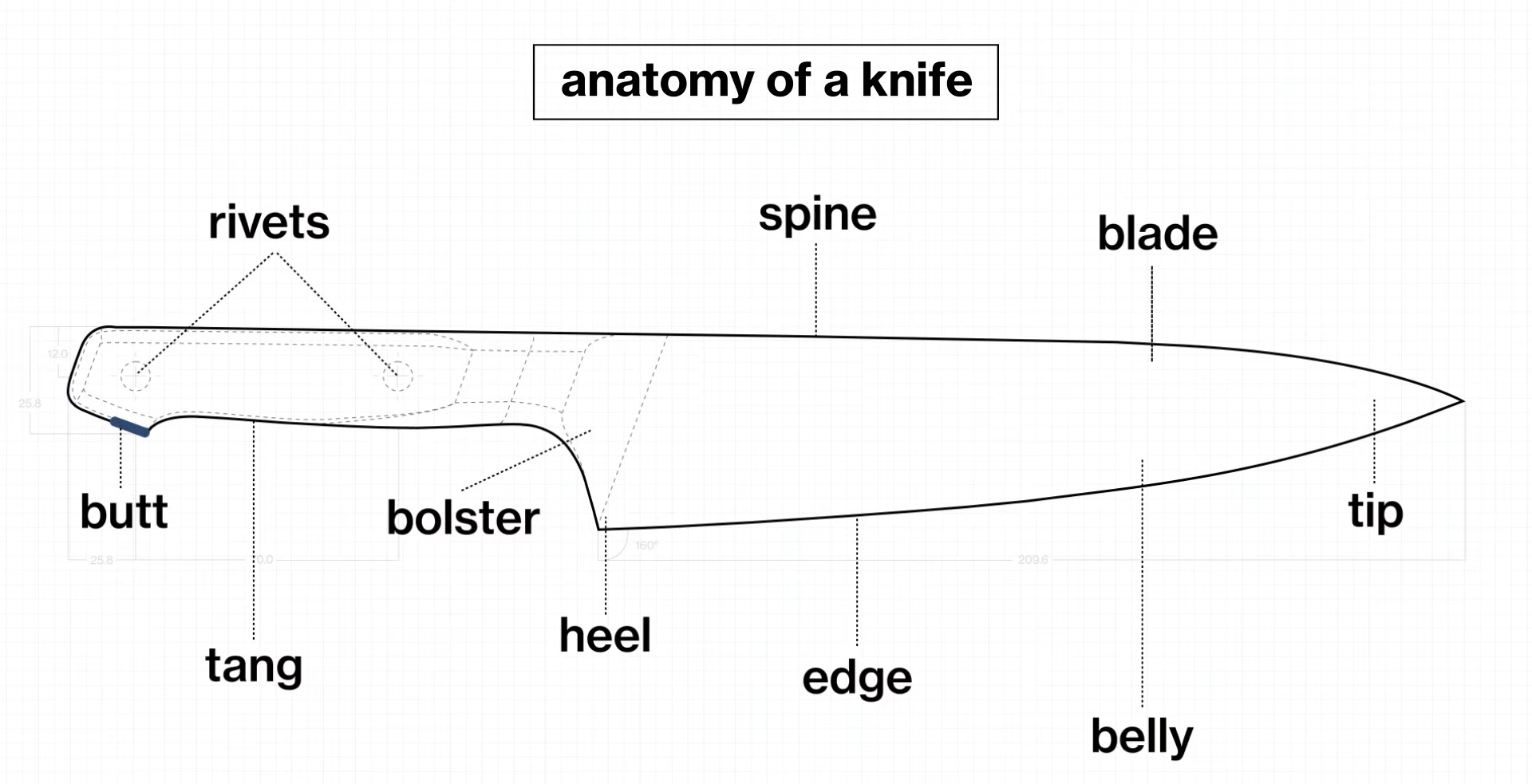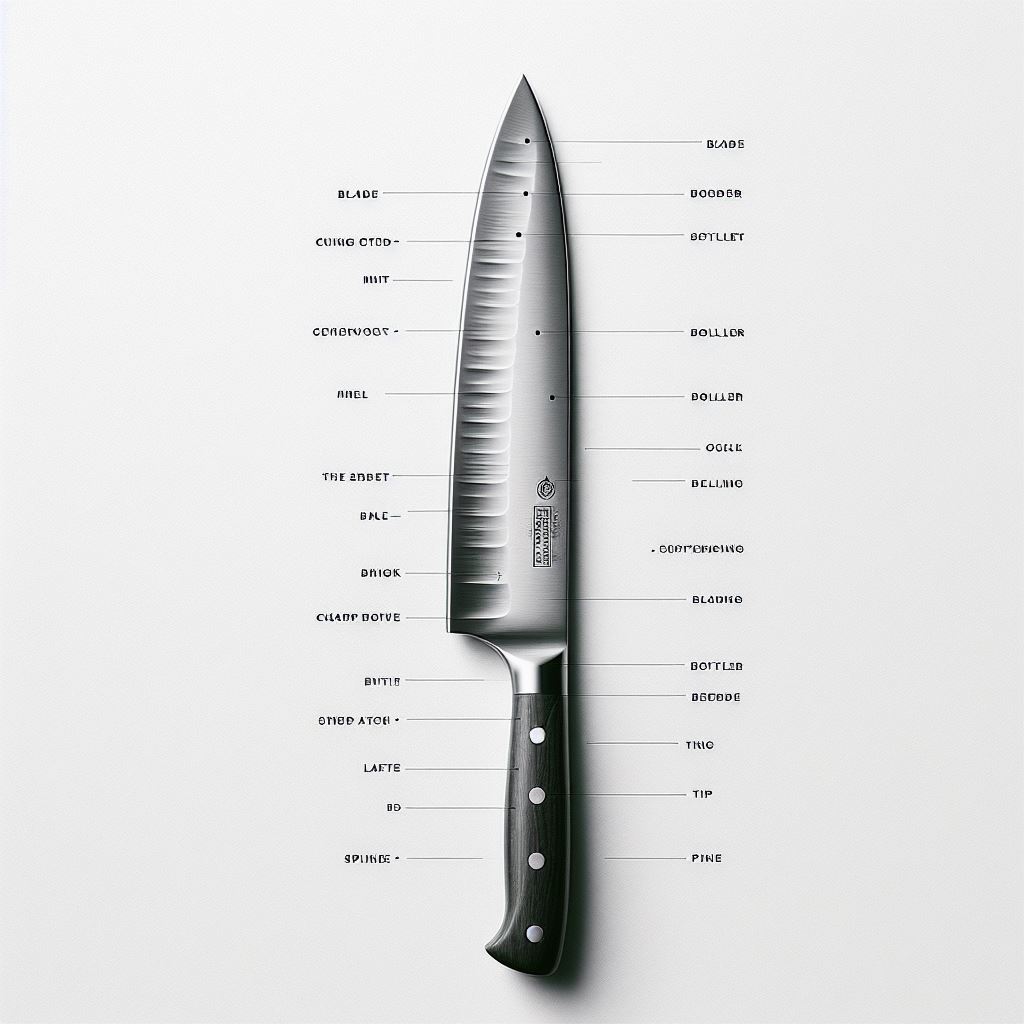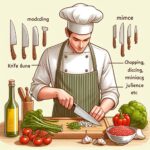A chef’s knife typically comprises a blade, a spine, a tip, an edge, a heel, a bolster, a handle, tang, and rivets. Each part serves a specific function in handling and cutting efficiency.
Understanding the anatomy of a chef’s knife is essential for both professional chefs and culinary enthusiasts. The blade is the broad, sharp part used for slicing, the spine provides stability, and the tip aids in precise cuts. The edge is the sharpened side, perfect for chopping, while the heel is the blade’s rear, offering heft for tougher cuts.
The bolster, located between the blade and the handle, balances the knife and protects fingers. The handle grants grip and control, with the tang inside it lending durability, and rivets secure the handle to the tang. Knowledge of these components helps in selecting the right chef’s knife for specific culinary tasks, ensuring safety, comfort, and precision in the kitchen.
Introduction To The Chef’s Knife
A chef’s knife is not just a tool; it’s an extension of the chef’s hand. Whether an amateur cook or a professional chef, the chef’s knife remains a staple in any kitchen. Understanding its parts and functionalities enhances precision in cutting, slicing, and dicing, turning simple ingredients into culinary masterpieces.
The Importance Of A Chef’s Knife In The Culinary World
The chef’s knife often stands as the most versatile and frequently used cooking tool in the kitchen. Mastery over this knife can equate to improved efficiency, speed, and safety during food preparation. A chef’s dexterity with their knife helps in executing a variety of cuts which helps in elevating the presentation and texture of dishes.
Overview Of The Components Of A Chef’s Knife
- Blade: The core functional component which performs the cutting action.
- Edge: The sharpened side of the blade which slides through food items.
- Spine: The unsharpened, thick top side of the blade gives structure and stability.
- Point: The sharp tip of the knife that pierces and starts cuts.
- Heel: The rear part of the edge, typically used for tasks requiring more force.
- Bolster: The thick junction between the blade and handle for balance and hand protection.
- Handle: The section where the knife is held, providing grip and control.
- Rivets: Metal pieces that fasten the handle scales to the tang for durability.
- Tang: The part of the blade that extends into the handle for strength and balance.
- Butt: The end part of the handle, which can sometimes be used to crush ingredients.

Anatomy Of A Chef’s Knife
The essential tool in a chef’s arsenal is undoubtedly the chef’s knife—a marvel of craftsmanship and engineering. It’s much more than a blade and handle. Every part has a functional purpose designed to enhance kitchen performance and culinary precision. A thorough understanding of your chef’s knife can transform your cooking experience. Here we dissect the key components, exploring the significance and maintenance of each aspect.
The Blade: Material And Design
The blade is the heart of the chef’s knife, where its quality is paramount. Knives vary greatly in the materials used, with high-carbon stainless steel being a popular choice for durability and rust resistance. Blade design also plays a pivotal role in the knife’s functionality, with factors like the curvature impacting chopping efficiency.
- Stainless Steel: Resistant to rust, easy to maintain.
- Carbon Steel: Holds a sharper edge, requires more care.
- Ceramic: Extremely sharp, prone to chipping.
- Damascus: Hard steel core, patterned, durable.
The Edge: Sharpness And Maintenance
A knife’s edge dictates its cutting prowess. A finely honed edge requires less force, yielding precise cuts and ensuring safety. Maintaining the edge involves regular sharpening and honing. A well-kept edge significantly extends the life and efficiency of the knife.
| Maintenance Tool | Usage |
|---|---|
| Whetstone | For sharpening the edge, refining the angle. |
| Honing Rod | To realign the edge, preserving sharpness between sharpening sessions. |
| Electric Sharpener | Convenient sharpening, though less control over the process. |
The Spine: Thickness And Balance
The spine’s thickness contributes to the knife’s weight and balance, affecting the user’s control over precise cuts. A robust spine provides stability for tough ingredients, while a thinner spine is suited for more delicate tasks. A balanced knife feels comfortable in the hand, minimizing fatigue during prolonged use.
- Check balance: Pinch the knife near the bolster, see if it tilts.
- Assess weight: Heavy for chopping, light for slicing.
- Examine thickness: Match the task to the spine’s width.
The Tip: Precision Cutting And Puncturing
The tip of the chef’s knife is essential for detail-oriented tasks. From intricate vegetable carvings to puncturing tough skins, the tip’s shape influences its suitability for various jobs. A sharp, pointed tip provides agility and control, a virtual extension of the chef’s hand.
- Julienne slicing
- Dicing onions
- Piercing meats
The Handle: Grip And Ergonomics
In the culinary world, the performance of a chef’s knife is not just about the blade; the handle plays a crucial role in ensuring precision, comfort, and safety. A well-designed handle with optimal grip and ergonomics can transform the cooking experience, allowing chefs to chop, slice, and dice with ease and confidence. Let’s dive into the various elements that contribute to the functionality of a knife handle.
Handle Materials: Pros And Cons
Choosing the right material for your knife handle affects both the longevity and the feel of the knife. Here’s a quick rundown of popular handle materials:
- Wood: Traditional and aesthetically pleasing but requires more maintenance to prevent water damage.
- Plastic: Lightweight and low-maintenance, but may not offer the same feel or durability as other materials.
- Stainless Steel: Durable and easy to clean, yet can be slippery when wet.
- Composite: A blend of materials that often provides a balance of durability and comfort.
The Tang: Full Vs Partial
The tang is the part of the knife blade that extends into the handle and is a key factor in the knife’s balance and stability. Here’s a comparison:
| Full Tang | Partial Tang |
|---|---|
| Runs the entire length of the handle, offering excellent balance and durability. | Does not extend fully, making the knife lighter but potentially less balanced. |
Rivets And Scales: Ensuring A Secure Hold
For a handle to remain secure in your grip, it is often held together by rivets and scales. Here’s what they contribute:Rivets These are the metal pins you see on the handle that secure the scales (the sides of the handle) to the tang. Scales Made from wood, plastic, or other materials, scales provide the shape and contour of the handle and are crucial for comfort and control.
Balance And Weight
Understanding the balance and weight of a chef’s knife is crucial when selecting the perfect tool for your culinary adventures. A well-balanced knife feels like an extension of your hand, allowing for easy maneuverability and less fatigue during use. Similarly, the weight of the knife can influence your chopping precision and the effort required for each task. Together, balance and weight play pivotal roles in the performance and efficiency of a chef’s knife.
Finding The Balance Point: Blade Vs Handle
The balance point of a chef’s knife is the spot where the weight of the blade equals the weight of the handle. This equilibrium is fundamental for ensuring optimal control and comfort. The perfect balance point differs based on personal preference and cutting technique. Let’s explore how to find the balance point:
- Grip the knife by placing your finger under the blade, near the handle.
- Adjust the position of your finger until the knife rests horizontally without tipping over.
- This precise location is the knife’s balance point.
A blade-heavy knife might be preferred for chopping tough vegetables, while a handle-heavy knife could offer more control for delicate tasks.
The Significance Of Knife Weight In Food Preparation
The weight of a chef’s knife has a substantial impact on food preparation efficiency and user comfort. Heavier knives can handle dense foods with less effort, while lighter knives provide greater agility and are less tiring over extended use. Choosing the right knife weight is a matter of personal preference and the nature of the tasks at hand:
- Heavy knives (above 8 ounces) are ideal for:
- Slicing through thick meats
- Breaking down poultry
- Chopping hard vegetables
- Lighter knives (under 8 ounces) excel at:
- Mincing herbs
- Chopping soft vegetables
- Precise cutting requirements
Understanding the dynamics of knife weight and how it interacts with the force of cutting can transform the cooking experience. Select a knife that feels well balanced and comfortable for your style of food preparation to enhance your culinary prowess.
Additional Features And Variations
Welcome to the refined world of culinary craftsmanship where every detail matters. Exploring the anatomy of a chef’s knife reveals a treasure trove of features each designed to enhance the cutting experience. Let’s slice into the additional attributes and variations that set a professional chef’s knife apart from the rest.
Bolster: Safety And Finger Protection
The bolster of a knife is the thick junction between the handle and the blade. It’s not just a transitional piece; it serves crucial purposes:
- Weight: Provides balance to the knife, making it easier to handle.
- Stability: Anchors the knife, allowing for improved control during slicing and dicing.
- Safety: Acts as a barrier for your fingers, preventing them from sliding onto the blade while in use.
Heel: Force And Chopping Techniques
The heel is the rear part of the blade, closest to the handle. It’s the broadest and thickest portion and is specifically designed for:
- Powerful Cuts: Enabling the chef to exert more force, useful for tough items like carrots or squash.
- Chopping: The ideal section for rocking-chopping techniques used for herbs and vegetables.
- Endurance: Can withstand repetitive striking on the cutting board without damage.
Granton Edge: Reducing Food Stickiness
A knife with a Granton edge features scalloped grooves along the sides of the blade. These indentations have key benefits:
- Minimizing Friction: The grooves create air pockets which reduce drag when slicing through sticky foods such as potatoes or cheese.
- Easier Release: These pockets also prevent food from clinging to the blade, making for a cleaner cut and easier food prep.
- Finer Slices: The edge promotes precision cuts and finer slices especially valuable when presentation matters.
Care And Maintenance Of A Chef’s Knife
The care and maintenance of a chef’s knife is crucial not only to preserve its functionality and efficiency but also to ensure safety in the kitchen. A well-maintained chef’s knife can make food preparation more enjoyable, precise, and swift. Below are essential ways to maintain the integrity of this indispensable kitchen tool, encompassing sharpening and honing practices, correct cleaning and storage techniques, and what misuses to steer clear of.
Sharpening And Honing: Keeping The Edge Keen
A sharp knife is a safe knife. Keeping your chef’s knife with a keen edge requires regular attention. Learn the difference between sharpening and honing to provide the proper care for your knife.
- Sharpening involves removing material from the blade to create a new edge. This process should be done occasionally, depending on how often the knife is used.
- Honing, on the other hand, is a more frequent task. It realigns the knife’s edge without removing significant material. Use a honing steel before each use to keep the blade in tip-top condition.
Proper technique is critical when sharpening or honing a chef’s knife. Use consistent angles and even pressure to maintain the blade’s integrity.
Cleaning And Storage: Prolonging The Life Of Your Knife
A clean knife is a happy knife, and proper storage ensures it stays that way. Follow these tips to keep your chef’s knife in the best condition:
- Clean your knife immediately after use to prevent residue from hardening, making it easier to remove and reducing the risk of corrosion.
- Hand-wash with warm, soapy water and dry immediately with a soft towel to avoid water spots and rust formation.
- Store the knife in a dry place. Use a knife block, sheath, or a magnetic strip to prevent blade damage and to keep it out of reach of children.
Consistent cleaning and thoughtful storage guard the knife against premature wear and keep it hygienic and ready for the next culinary task.
Common Misuses To Avoid
To ensure a long life for your chef’s knife, be mindful of how you use it. Avoid the following misuses:
| Misuse | Explanation |
|---|---|
| Using as a can opener | This can dull or damage the blade and is a safety hazard. |
| Cutting on hard surfaces | Always use a cutting board. Hard surfaces like glass or metal can blunt your knife’s edge. |
| Using for prying | The blade is not designed to pry open objects, as this can bend or break the tip. |
| Dishwasher cleaning | The harsh environment inside a dishwasher can dull the knife and cause corrosion. |
By avoiding these common mistakes, your chef’s knife will remain a reliable and efficient tool in your kitchen arsenal.
Selecting The Right Chef’s Knife
A chef’s knife is the cornerstone of any kitchen, essential for a range of tasks from chopping vegetables to finely mincing herbs. Selecting the right chef’s knife can enhance your culinary prowess and turn cooking into a seamless process. But with countless options available, choosing the perfect blade for your needs may seem daunting. Let’s dive into the factors to consider, the different types available, and how to evaluate knives within your budget for the ultimate cutting experience.
Factors To Consider When Purchasing
- Handle Comfort: A comfortable grip reduces fatigue and improves precision.
- Blade Material: Options include stainless steel, carbon steel, and ceramic, each with distinct maintenance and performance characteristics.
- Blade Length: Typically ranging from 6 to 14 inches, the right length depends on your comfort and the tasks at hand.
- Weight: The knife’s weight should balance control with the force needed for chopping.
- Balance: Proper balance between the handle and the blade is critical for control during cutting.
- Edge Retention: Look for knives that maintain sharpness over time, reducing the frequency of sharpening.
Different Types Of Chef’s Knives For Various Culinary Tasks
| Type of Knife | Best for | Characteristics |
|---|---|---|
| Classic Chef’s Knife | Dicing, slicing, and chopping | Curved blade for a rocking motion |
| Santoku Knife | Slicing, dicing, and mincing | Straight edge with a sheepfoot blade that ends in a rounded tip |
| Nakiri Knife | Chopping vegetables | Rectangular blade perfect for an up-and-down motion, without the need for rocking |
| Utility Knife | General-purpose; smaller tasks | Smaller than a chef’s knife but larger than a paring knife |
Evaluating Quality And Price Range
The search for a quality chef’s knife often leads to a consideration of the price—yet the most expensive option isn’t always the best. Focus on craftsmanship, material quality, and brand reputation. Conducting a hands-on examination, if possible, can be invaluable. Test the knife’s sharpness, balance, and ergonomics to ensure it meets your standards.
For those on a budget, numerous brands offer excellent value without compromising on durability or functionality. It’s about finding the right blend of features that cater to your specific culinary needs. Remember, a well-maintained knife from a mid-range price bracket can often rival the performance of higher-end models.

Conclusion
Understanding the distinct parts of a chef’s knife is essential for any culinary enthusiast. Grasping what each component does will sharpen your kitchen skills. Choose your blade wisely, care for it diligently, and your cooking precision will surely improve. Remember, a well-informed chef is always at the cutting edge of gastronomy.
Frequently Asked Questions Of Parts Of A Chef’s Knife
What Is A Chef’s Knife Used For?
A chef’s knife, also known as a cook’s knife, is a versatile kitchen tool used for a variety of food preparation tasks. It’s designed for slicing, dicing, chopping, and mincing a range of ingredients, including meats, vegetables, and herbs. Its broad and heavy blade makes it an essential for both home cooks and professional chefs.
What Are The Main Parts Of A Chef’s Knife?
A chef’s knife consists of several key parts, including the blade, edge, spine, point, heel, bolster, handle, and tang. Each part serves a specific purpose in aiding the knife’s overall function and performance, from providing balance and strength to ensuring precision and control during cutting.
How Does The Bolster Contribute To Knife Safety?
The bolster of a chef’s knife provides a smooth transition between the blade and handle, offering a comfortable grip and better control. It serves as a finger guard, protecting the user’s fingers from sliding onto the blade, thus enhancing safety during cutting, chopping, or slicing tasks.
Can You Sharpen All Parts Of A Knife’s Edge?
Typically, the entire edge of a chef’s knife, running from the point to the heel, can be sharpened. Regular honing and sharpening maintain the knife’s cutting efficiency. However, specific techniques may be required to adequately sharpen the curved versus straight sections of the blade.







